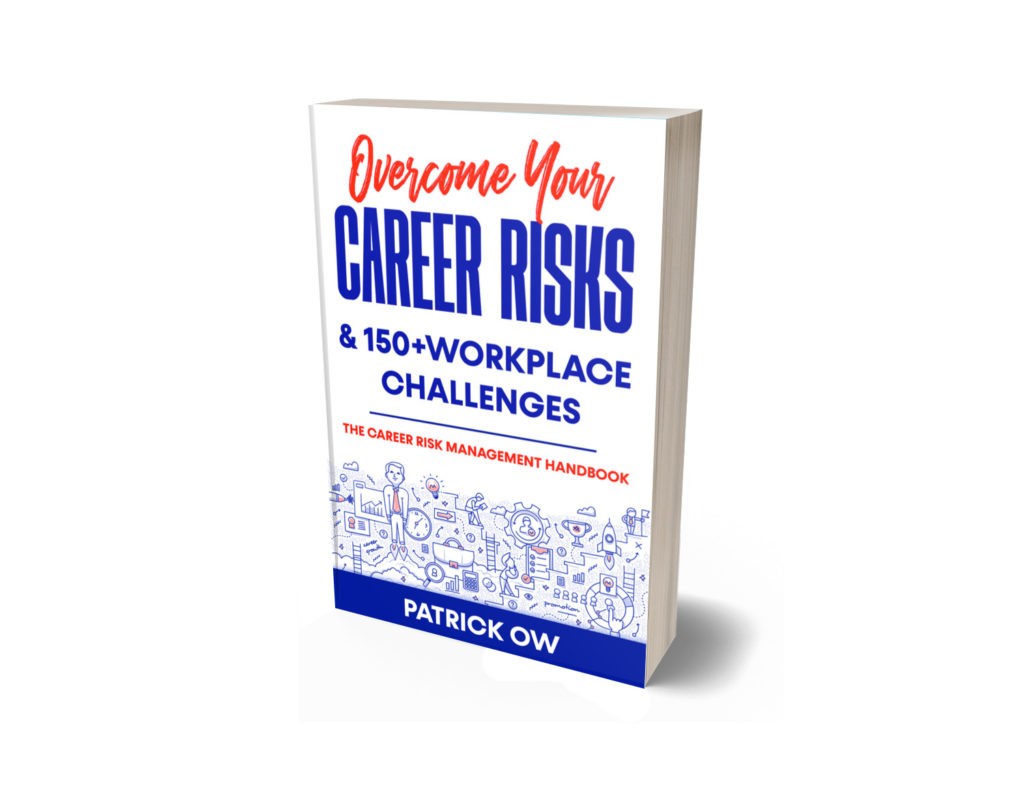Overcome Your Career Risks and 150+ Workplace Challenges: The Career Risk Management Handbook

In this incredibly practical handbook, Patrick Ow (of PracticalRiskTraining.com) gives an amazing amount of how-to detail to overcome your career risks and the 150+ workplace challenges.
The key to your success is to find the critical path to your success and work hard to remove those key barriers.
No matter how bad your relationship with someone is, it’s almost always better to build your career in your current organization than to go somewhere else.
The saying, “better the devil you know than the devil you don’t” holds true.
It is better to deal with a difficult person or situation you know than to deal with a new person or situation that you don’t know in a new organization. It could be worse than the current situation!
When you interact with another organization during recruitment, you interact with the people who like you, who want you to join. But when you join, you’re going to be working with people who didn’t recruit you, who didn’t like you, who didn’t want you to join. Then you going to see how much deficit you have.
There will always be people who you will have to work with that you do not like.
While it’s easy to leave, it’s usually much harder to start something new and to build personal relationships from ground zero. Work with what you have, even if it doesn’t feel like the best option. In real terms, it usually is the best option.
Start by writing out the ideal resume you would need when applying for your dream job in your dream employer three to five years from today. These are your career goals and objectives.
This forces you to create a critical path timeline of prioritized milestones and action steps to take to achieve your goals and objectives.
The next step is to execute your career plan achieve each goal in the resume. Remove all non-necessities, costs, and time, and focus exclusively on the goals that are laid out in your resume.
By reading this book, you will learn how to:
1. Identify the types of career risks you may face.
2. Create and implement a career growth strategy.
3. Identify and close gaps in your knowledge, abilities, and skills.
4. Intentionally build up your achievements.
5. Resign gracefully and manage counteroffers tactfully.
6. Mitigate your career risks and maximize your career opportunities.
7. Build something of value where you are at right now.
8. Use a critical path to maximize the likelihood and extent of your career success.
This book provides practical career risk management strategies and solutions for overcoming career risks and workforce challenges related to the achievement of your career goals and objectives. It includes reigniting your love and passion for your job.
Contents
Preface
What is a career risk?
Develop your career objectives
Create and implement a career growth strategy
Identify and close gaps in your knowledge, abilities, and skills
Intentionally build up your achievements
Resign gracefully and manage counteroffers tactfully
Career risks you should never take
Career opportunities you should take
It’s easier to build something of value where you are at right now
Develop a critical path for your career
Appendixes
134 Challenges faced by employees and workers
47 Challenging faced by young people
75 Ways to love your work
Why read this book?
Some of the most important lessons you will learn or have learned in the real world come from one source – the school of hard knocks.
There will be decisions and choices about the work you do and the career your will embark on that you will make until you find the right one. Making job and career choices involve making mistakes and learning from them.
You make ‘mistakes’ to become effective in achieving your goals and objectives.
There will be inevitable failures that you can’t predict, opportunities that end up being too good to be true, or moments when you don’t live up to your potential.
Although these failures may seem career-ending at the moment, these ‘setbacks’ can prove their value over time. In part, it’s because they are mistakes that you’ll never forget or repeat.
When you’re facing a position where you have a choice to leave an organization you must keep in mind that if you leave your employer, you will be abandoning all the intellectual property, all the built-up goodwill, and all the relationships you developed since joining the organization.
You have effectively abandoned all the hard work that you have sowed all these years in creating a name and brand for yourself, proving yourself as a capable and high performing employee.
While you may have accumulated all the transferable skills and experience that you can take to your next job, it is those softer sides of things like your brand and human relationships that have taken you years to build up, brick by brick, that will be lost in an instant.
While it may sound very exciting to start in a new organization, but it’s not easy.
Unless you are lucky enough to start on good footing and build your name, presence, and relationships rapidly in the new organization, you will start with a major deficit.
You must build all the relationships from ground zero. Relationships take time and hard work to nurture.
In your current organization, you likely don’t have a deficit. You only don’t know how to move forward. There’s a big difference.
When you start in any new organization, you will incur a major deficit. Remember this, there is no perfect job.
Running away and leaving your current job may sound good at this point, by it will make more sense was to find the critical path for you to change his career and then move past certain people around and above you who are barriers for you to be promoted or grow professionally.
In project management, a critical path is the sequence of project network activities that add up to the longest overall duration, regardless if that longest duration has float or not, to achieve the project objectives. This determines the shortest time possible to complete the project. There can be ‘total float’ (unused time) within the critical path.
Likewise, your career’s critical path is the sequence of inter-dependent activities that you must do to achieve your career goals and objectives. A career without a critical path is like a ship without a rudder.
There are career risks and more than 150+ workplace challenges that you need to overcome to be successful.
The key to your success is to find the critical path to your success and work hard to remove those key barriers.
No matter how bad your relationship with someone is, it’s almost always better to build your career in your current organization than to go somewhere else.
The saying, “better the devil you know than the devil you don’t” holds true.
It is better to deal with a difficult person or situation you know than to deal with a new person or situation that you don’t know in a new organization. It could be worse than the current situation!
When you interact with another organization during recruitment, you interact with the people who like you, who want you to join. But when you join, you’re going to be working with people who didn’t recruit you, who didn’t like you, who didn’t want you to join. Then you going to see how much deficit you have.
There will always be people who you will have to work with that you do not like. And it may take up to eight sessions of interactions to change their minds and get them on your side.
While it’s easy to leave, it’s usually much harder to start something new and to build personal relationships from ground zero. Work with what you have, even if it doesn’t feel like the best option. In real terms, it usually is the best option.
Use tools like the Myers-Briggs Type Indicator® (MBTI®) personality inventory to understand the personality type of the people you are dealing with. Learn how to use the strengths of your personality to maximize the outcome that you want when interacting with people who are different from you.
Improve your emotional intelligence. By understanding your emotions and how to control them, you’re better able to express how you feel and understand how others are feeling. This allows you to communicate more effectively and forge stronger relationships, both at work and in your personal life.
Your manager, like everyone else, has deep motivations. Knowing what these ‘true’ motivations are will be incredibly useful given that you’re working under her, in the same way, that understanding ‘true’ motivations for each person on your team makes it easier for you to work with each of them.
By understanding your manager’s motivation, they are more receptive if you frame your response in terms of what motivates them.
If you can present your proposal to answer your manager’s question of “What’s in it for me?”, you are closer to winning.
When you face a difficult situation, you need to develop a plan for it. You just have to see your situation from a big picture perspective. Come up with a plan.
Then find the discipline to execute it. This is the hardest part. But you must do it if you want to have a successful career.
Your plan will consist of all the elements of a critical path. These are key steps you need to follow.
Knowing a critical path will help you differentiate what is important and you have to focus on following the critical path, day after day.
Start by writing out the ideal resume you would need when applying for your dream job in your dream employer three to five years from today. These are your career goals and objectives.
This forces you to create a critical path timeline of prioritized milestones and action steps to take to achieve your goals and objectives.
The next step is to execute your career plan achieve each goal in the resume. Remove all non-necessities, costs, and time, and focus exclusively on the goals that are laid out in your resume.

